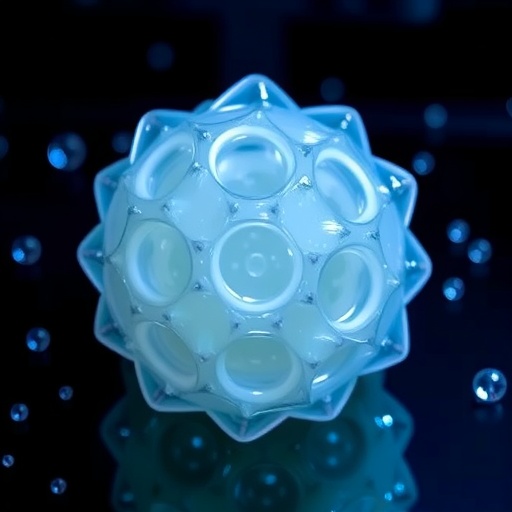In the ever-evolving world of polymer chemistry, the quest for materials that combine performance with environmental responsibility remains paramount. Traditional plastics, while indispensable due to their robustness and chemical stability, pose a pressing ecological challenge. Their resilience, which makes them so useful, unfortunately also leads to long-term persistence in natural environments, contributing significantly to plastic pollution. Addressing this issue, a pioneering team of researchers from Doshisha University in Japan has embarked on an insightful journey into the radical ring-opening polymerization (RROP) of cyclic ketene acetals (CKAs), paving the way for next-generation biodegradable polymers with finely tunable degradation profiles.
Cyclic ketene acetals represent a fascinating class of monomers characterized by their distinctive five-membered ring structure consisting of carbon and oxygen atoms. Their unique architecture facilitates a radical ring-opening polymerization mechanism that introduces ester linkages directly into the polymer backbone, an attribute instrumental in imparting degradability to the resulting polymers. Conventional polymers often lack these cleavable sites, rendering them persistent in the environment. Despite the promise held by CKAs in generating degradable polyesters, the exact ramifications of altering the monomer structure on the kinetics and pathways of polymerization have remained shrouded in scientific uncertainty.
In a comprehensive study led by Assistant Professor Shin-nosuke Nishimura and Professor Tomoyuki Koga from Doshisha University’s Department of Molecular Chemistry and Biochemistry, the team sought to demystify the influence of monomer asymmetry on RROP behavior. Their work, recently published in the prestigious journal Macromolecules, ventures beyond mere synthesis and characterization, integrating experimental polymerization with sophisticated computational modeling. This dual approach is set to reshape our fundamental understanding of how subtle structural variations in CKAs can decisively govern polymer microstructure and biodegradability.
To initiate their investigation, the researchers synthesized a series of novel asymmetric CKAs, specifically 5-membered rings bearing alkoxymethyl substituents at the 4-position. These modifications are subtle yet deliberated, aiming to scrutinize how such side groups affect polymerization dynamics. Utilizing nuclear magnetic resonance (NMR) spectroscopy, the team meticulously confirmed the molecular structures of these monomers, ensuring precise correlation between structure and reactivity in subsequent analyses.
Among the synthesized derivatives, a particular monomer labeled 5a was subject to in-depth exploration under varying chemical environments and thermal conditions. NMR spectra unveiled that polymers derived from 5a consistently contained polyester units, a structural hallmark that signals potential biodegradability. To validate this, the team employed OECD 301F standard biodegradability tests, benchmarking the degradation performance of 5a-based polymers against cellulose — a naturally occurring biodegradable polymer. Impressively, although not as rapid as cellulose, the 5a polymers exhibited a notable 20% degradation rate, demonstrating a meaningful step toward environmentally benign alternatives.
A focal point of the study was assessing how chemical alterations at the alkoxymethyl group influence the polymerization mechanics and resulting polymer architecture. By varying monomer concentrations and reaction temperatures during polymerization, the researchers observed the behavior of 5a contrasted against a simpler, non-substituted 5-membered CKA named C5. Importantly, their results revealed that 5a was resilient to forming “backbiting” structures — unstable intramolecular interactions known to adversely impact polymer properties — even under challenging high-temperature conditions and fluctuating monomer levels. This resilience is critical for ensuring consistent polymerization and predictable material behavior.
The integrity of the polymer backbone, especially concerning ring retention, is a vital determinant of polymer degradability. Ring retention introduces inert moieties that resist cleavage, thus hindering the environmental breakdown of polymers. Through meticulous NMR spectroscopic analyses of reaction solutions, the researchers demonstrated that 5a CKA maintained less than 10% ring-retaining fractions across varied chemical scenarios. This low ring retention fraction substantiates that most monomer units are effectively ring-opened during polymerization, facilitating polyester formation conducive to degradation.
A particularly innovative aspect of the work was the development of a kinetic simulation model grounded in density functional theory (DFT) calculations, a quantum mechanical computational approach that allows detailed evaluation of molecular energetics and reaction pathways. This model not only corroborated the experimental findings for 5a but also elucidated mechanistic insights into the radical polymerization process, thereby bridging the gap between theoretical predictions and laboratory observations. The combination of experimental polymer chemistry and theoretical kinetics holds promise for rationally engineering monomers with tailor-made reactivity profiles.
Assistant Professor Nishimura shared his vision about the broader applications of these discoveries. He emphasized the transformative potential for creating practical biodegradable materials, ranging from environmentally friendly packaging capable of mitigating microplastic contamination, to agricultural mulch films designed to degrade after performing their protective function, and even to biomedical materials engineered for safe in vivo degradation. The study marks a crucial advance toward sustainable polymer technologies that align with global ecological goals.
Looking forward, Nishimura projects that within the next five to ten years, the kinetic model developed by their team could serve as a fundamental platform for designing radical polymerization procedures that are both synthetically reliable and environmentally sustainable. This foresight underscores how integrating computational and experimental methodologies can accelerate the development of polymers that meet both industrial and environmental standards without compromise.
In essence, the study elucidates how structural asymmetry within five-membered CKAs affects radical ring-opening polymerization, offering a novel paradigm to engineer biodegradable polymers with predictable and controllable properties. Such advancements not only foster scientific understanding of polymer reaction kinetics but also pave the way for novel materials that address critical environmental challenges posed by plastic persistence.
This research exemplifies the synergy of molecular design, experimental polymer synthesis, advanced spectroscopic techniques, and quantum chemical modeling in unveiling the subtleties of degradable polymer formation. As global demand intensifies for sustainable materials, these findings hold the promise of inspiring further innovation in polymer chemistry and materials science, tracking a path toward a greener future.
Subject of Research: Not applicable
Article Title: Kinetic Model of Radical Ring-Opening Polymerization of Asymmetric Five-Membered Cyclic Ketene Acetals
News Publication Date: 19-Aug-2025
Web References:
https://doi.org/10.1021/acs.macromol.5c01438
Keywords
Molecular chemistry, Environmental chemistry




